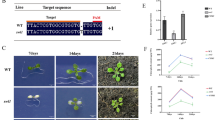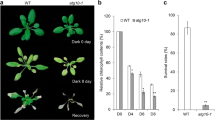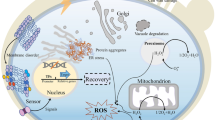Abstract
We report on a new cDNA clone (Qshsp10.4-CI) of a Quercus suber L. class-CI small heat-shock protein (sHsp) obtained from cork (phellem), a highly oxidatively stressed plant tissue. The deduced gene product lacks the C-terminal extension and the consensus I region of the α-crystallin domain, being the most C-terminally truncated sHsp reported to date. In an attempt to prove that a protective function is possible for such a truncated sHsp, we overexpressed in Escherichia coli three recombinant sHsp-CIs, one (rQsHsp10.4-CI) showing the same truncation as Qshsp10.4-CI, a second (rN49) lacking the whole α-crystallin domain, and a third (rN153) consisting of a full-length sHsp-CI. The overexpression of rN153 and, remarkably, rQsHsp10.4-CI but not rN49 enhanced cell viability under high temperature and, interestingly, under oxidative stress. These results show that the C-terminal extension and the consensus I region of the α-crystallin domain are dispensable, but amino acids 1–41 of the α-crystallin domain (including the consensus II region) are essential for the protective activity of sHsp-CIs. On the other hand, two-dimensional immunodetection patterns showed accumulation of ca. 10-kDa sHsp-CI immunorelated polypeptides in cork and other oxidatively stressed tissues but not in control and heat-stressed tissues. We discuss the possible role of highly truncated sHsps in relation to oxidative stress.



Similar content being viewed by others
Abbreviations
- 2D:
-
two-dimensional
- sHsp:
-
small heat-shock protein
- sHsp-CI:
-
class-I sHsp
- IPTG:
-
isopropyl β-d-thiogalactopyranoside
References
Beissinger M, Buchner J (1998) How chaperones fold proteins. Biol Chem 379:245–259
Collada C, Gómez L, Casado R, Aragoncillo C (1997) Purification and in vitro chaperone activity of a class I small heat shock protein abundant in recalcitrant chestnut seeds. Plant Physiol 115:71–77
Crawford DR, Davies KJA (1994) Adaptive response and oxidative stress. Environ Health Persp [Suppl 10] 102:25–28
Forreiter C, Kirschner M, Nover L (1997) Stable transformation of an Arabidopsis cell suspension culture with firefly luciferase providing a cellular system for analysis of chaperone activity in vivo. Plant Cell 12:2171–2181
Horwitz J (2000) The function of alpha-crystallin in vision. Semin Cell Dev Biol 11:53–60
Jinn TL, Wu SH, Yeh CH, Hsieh MH, Yeh YC, Chen YM, Lin CY (1993) Immunological kinship of class I low molecular weight heat shock proteins and thermostabilization of soluble proteins in vitro among plants. Plant Cell Physiol 34:1055–1062
Joe MK, Park SM, Lee YS, Hwang DS, Hong CB (2000) High temperature stress resistance of Escherichia coli induced by a tobacco class I low molecular weight heat-shock protein. Mol Cells 10:519–524
Kolattukudy PE, Podila GK, Roberts E, Dickman MD (1984) Gene expression resulting from early signals in plant–pathogen interaction. Can J Bot 62:2918–2933
Kitagawa M, Matsumura Y, Tsuchido T (2000) Small heat shock proteins, IbpA and IbpB, are involved in resistances to heat and superoxide stresses in Escherichia coli. FEMS Microbiol Lett 184:165–171
Lee GJ, Vierling E (2000) A small heat shock protein cooperates with heat shock protein 70 systems to reactivate a heat-denatured protein. Plant Physiol 122:189–197
Lee GJ, Pokala N, Vierling E (1995) Structure and in vitro molecular chaperone activity of cytosolic small heat shock proteins from pea. J Biol Chem 270:10432–10438
Lee GJ, Roseman AM, Saibil HR, Vierling E (1997) A small heat shock protein stably binds heat-denatured model substrates and can maintain a substrate in a folding-competent state. EMBO J 16:659–671
Leroux MR, Ma BJ, Batelier G, Melki R, Candido EP (1997a) Unique structural features of a novel class of small heat shock proteins. J Biol Chem 272:12847–12853
Leroux MR, Melki R, Gordon B, Batelier G, Candido EP (1997b) Structure–function studies on small heat shock protein oligomeric assembly and interaction with unfolded polypeptides. J Biol Chem 272:24646–24656
Löw D, Brändle K, Nover L, Forreiter C (2000) Cytosolic heat-stress proteins Hsp17.7 class I and Hsp17.3 class II of tomato act as molecular chaperones in vivo. Planta 211:575–582
MacRae TH (2000) Structure and function of small heat shock/alpha-crystallin proteins: established concepts and emerging ideas. Cell Mol Life Sci 57:899–913
Morange M, Favet N, Loones M-T, Manuel M, Mezger V, Michel E, Rallu M, Sage J (1998) Heat shock genes and development. In: P Csermely (ed) Stress of life: from molecules to man. Ann N Y Acad Sci 851:117–122
Pla M, Huguet G, Verdaguer D, Puigderrajols P, Llompart B, Nadal A, Molinas M. (1998) Stress proteins co-expressed in suberized and lignified cells and in apical meristems. Plant Sci 139:49–57
Pla M, Jofré A, Martell M, Molinas M, Gómez J (2000) Large accumulation of mRNA and DNA point modifications in a plant senescent tissue. FEBS Lett 472:14–16
Puigderrajols P, Jofré A, Mir G, Pla M, Verdaguer D, Huguet G, Molinas M (2002) Temporal and spatial distribution patterns of developmental and stress-induced small heat shock proteins in cork oak somatic embryos. J Exp Bot 53:1445–1452
Rajaraman K, Raman B, Ramakrishna T, Rao CM (2001) Interaction of human recombinant alphaA- and alphaB-crystallins with early and late unfolding intermediates of citrate synthase on its thermal denaturation. FEBS Lett 497:118–23
Scharf K-D, Siddique M, Vierling E (2001) The expanding family of Arabidopsis thaliana small heat proteins containing α-crystallin domains (Acd proteins). Cell Stress Chaperones 6:225–237
Smulders RHPH, Carver JA, Lindner RA, van Boekel MA, Bloemendal H, de Jong WW (1996) Immobilization of the C-terminal extension of bovine alphaA-crystallin reduces chaperone-like activity. J Biol Chem 271:29060–29066
Soto A, Allona I, Collada C, Guevara M, Casado R, Rodriguez-Cerezo E, Aragoncillo C, Gómez L (1999) Heterologous expression of a plant small heat shock protein enhances Escherichia coli viability under heat and cold stress. Plant Physiol 120:521–528
van Montfort RL, Basha E, Friedrich KL, Slingsby C, Vierling E (2001) Crystal structure and assembly of a eukaryotic small heat shock protein. Nat Struct Biol 8:1025–30
Varadarajan GS, Prakash CS (1991) A rapid and efficient method for the extraction of total DNA from sweet potato and its related species. Plant Mol Biol Report 9:6–12
Veinger L, Diamant S, Buchner J, Goloubinoff P (1998) The small heat-shock protein IbpB from E. coli stabilizes stress-denatured proteins for subsequent refolding by a multichaperone network. J Biol Chem 273:11032–11037
Wang K, Spector (1996) A alpha-crystallin stabilizes actin filaments and prevents cytochalasin-induced depolymerization in a phosphorylation-dependent manner. Eur J Biochem 242:56–66
Waters ER, Lee GJ, Vierling E (1996) The molecular evolution of smHSP in plants. J Exp Bot 47:325–338
Wehmeyer N, Vierling E (2000) The expression of small heat shock proteins in seeds responds to discrete developmental signals and suggests a general protective role in desiccation tolerance. Plant Physiol 122:1099–1108
Yeh CH, Chang PF, Yeh KW, Lin WC, Chen YM, Lin CY (1997) Expression of a gene encoding a 16.9-kDa heat-shock protein, Oshsp16.9, in Escherichia coli enhances thermotolerance. Proc Natl Acad Sci USA 94:10967–10972
Yeh CH, Chen YM, Lin CY (2002) Functional regions of rice heat shock protein Oshsp16.9, required for conferring thermotolerance in Escherichia coli. Plant Physiology 128:661–668
Acknowledgement
This work was supported by the Spanish Ministerio de Ciencia y Tecnología (Ramon y Cajal and INIA CAL01-058-C2-2 project).
Author information
Authors and Affiliations
Corresponding author
Rights and permissions
About this article
Cite this article
Jofré, A., Molinas, M. & Pla, M. A 10-kDa class-CI sHsp protects E. coli from oxidative and high-temperature stress. Planta 217, 813–819 (2003). https://doi.org/10.1007/s00425-003-1048-x
Received:
Accepted:
Published:
Issue Date:
DOI: https://doi.org/10.1007/s00425-003-1048-x




